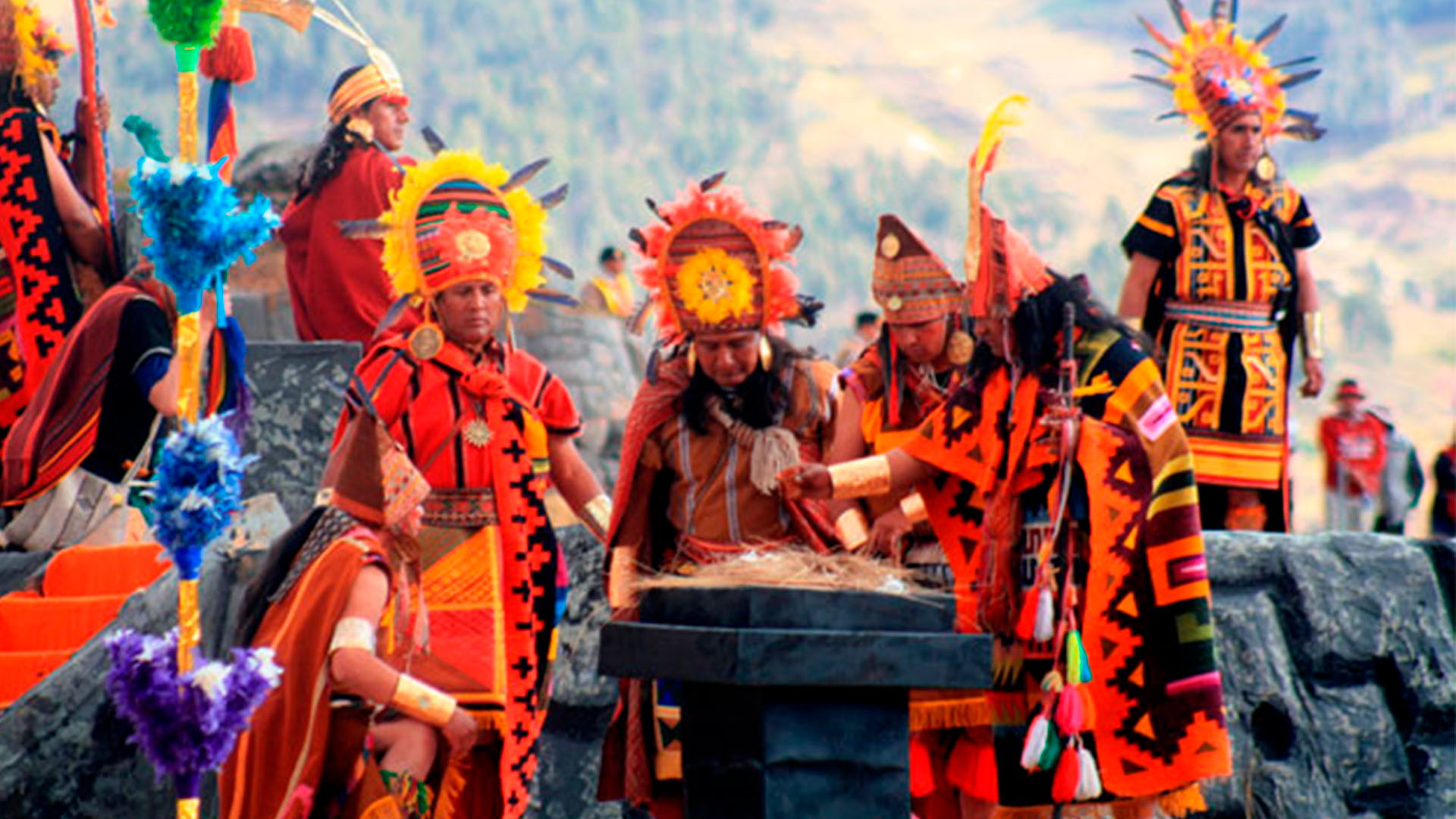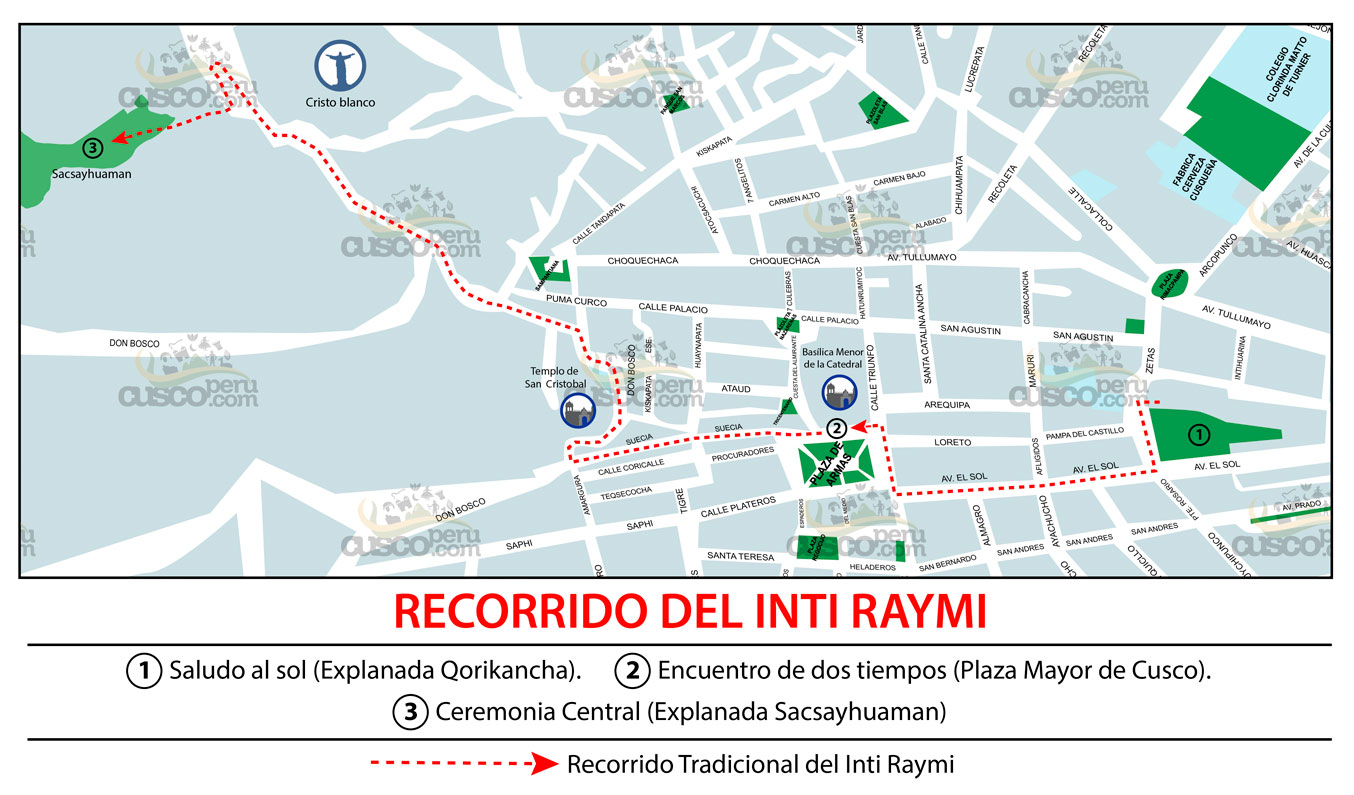


Inti Raymi is an ancient Inca religious celebration where the Incas worshipped their god: "The Inti or Sun" in the capital Cusco. Historically, the Inti Raymi lasted about 15 days, during which sacrifices were made, and dances were performed to honor the "Sun God." The last Inti Raymi held with the presence of the Inca Emperor was in 1535, a year before the "Spanish Conquest."
Currently, Inti Raymi is a theatrical representation, with thousands of Cusqueños and people from all over the world gathering at this event, which is one of the most important cultural and traditional manifestations of Cusco. This Inca celebration makes each of us feel the Inca blood running through our veins and revalues our past.
The Sun in Inti Raymi signifies its highest adoration, its essence, and its source of life. It is the supreme god and one of the most important stars in the Andean world, initiating a new annual cycle during this festival. Hence, offerings, temples, etc., were dedicated to the sun because it blessed them; therefore, it deserved respect and worship.
"Inti Raymi" or "Festival of the Sun" was the largest, most important, and magnificent festival held during the Tahuantinsuyo Empire. It based its religion on the worship of the Sun, established by Inca Pachacuti, “the world transformer,” in the 14th century as a religious reform, with the sun being its highest deity.
This ceremony involved the acllas, ayllus, the Imperial Inca army, representatives of each suyo, and other members of the Inca organization, attended by almost the entire population of Tahuantinsuyo.
The Inca's entrance to the Plaza de Armas or the esplanade of Saqsayhuaman was always led by a group of "Acllas" who scattered flowers and were accompanied by the "Pichaq," men who used straw brooms to drive away evil spirits that might be on the path.
The Inca, in all his outdoor appearances, was always accompanied by his "kumillo," a hunchbacked dwarf carrying the "Achiwa," a type of parasol or umbrella made of colored feathers.
During the conquest era, the Inca's subjects continued celebrating the festival secretly from the Spanish authorities. A mestizo named "Garcilaso de la Vega" collected the best of this festival and captured it in his famous work "Comentarios Reales."
The staging of Inti Raymi began with the proposal of Humberto Vidal Unda to the American Art Institute in 1943. The project was an initiative to stage an Inca ceremony, which at the time was only a small dramatization of an Inca festival.
Thus, in 1944, an unprecedented staging was carried out for the first time, known today as "Inti Raymi," and June 24 of each year was established as Cusco Day.
The first Inti Raymi celebrated after the Spanish conquest featured Don Faustino Espinoza Navarro as the Inca, a Cusqueño writer and actor, founder of the Academy of the Quechua Language, and participant in the reestablishment of this celebration.
In 2001, "Inti Raymi" was declared a Cultural Heritage of the Nation and an Official Act of National Identity.


The differences between Inti Raymi celebrated in the time of the Incas and Inti Raymi celebrated today are generally minimal. Here are the details that differ.
| Inti Raymi | Inca Inti Raymi | Current Inti Raymi |
|---|---|---|
| Description | A festival of much color, dance, and devotion, as well as rites and offerings to the Sun God. | A festival that revalues the traditions and customs of our Inca ancestors. |
| Duration | 15 days before the winter solstice | 1 day, June 24 |
| Year | 1430 - 1532 A.D. | 1944 - Present |
| Attendance | 50,000 inhabitants of the Tahuantinsuyo | 60,000 attendees from different parts of the world and approximately 1000 actors (musicians, dancers, etc.) |
It is known that the role of women in the Inca empire was very important and necessary, as they were a symbol of abundance and fertility. The central figure of women in the Inca empire was the Qoya, a figure that transcended leadership and the ability to manage crisis situations in Tahuantinsuyo. She was the companion of the Inca, his advisor, and his right hand in government. When the Inca died, she was responsible for leading the Panaca, the “noble descendants of the Inca.”
In the Inti Raymi Festival, the Qoya was a highly relevant character, accompanying the Inca throughout the ceremony, demonstrating sovereignty and power.
The Qhapac Ñan was a network of Inca roads intertwined through the Huacas, a system of communication routes among all the peoples that made up Tahuantinsuyo. It was of utmost importance, as during the Inti Raymi festival, it was used to reach Cusco.
On June 24 in the morning, this Inca tradition begins, starting its first staging at the Temple of the Sun, Qoricancha or Santo Domingo. Then we move to the main square of Cusco, and finally, we head to the esplanade of Saqsayhuaman, where the staging lasts approximately 2 hours. Finally, it ends around 3:30 p.m., although it may extend a few minutes longer.
| Location | Time | |
|---|---|---|
| First part: | Qoricancha - Temple of the Sun | 9:00 am |
| Second part: | Huacaypata - Main Square of Cusco | Approx. 10:30 am |
| Third part: | Fortress of Saqsayhuaman | Approx. 1:00 pm |
The traditional Inti Raymi route takes place in three historic and important locations in Cusco.
1. Qorikancha or Temple of the Sun, the starting point of the Inti Raymi route with the ceremony called "Greeting to the Sun". This first part begins with the sound of the pututos and the entry of the acllas, musicians, and dancers, followed by the reception of the Inca. This place marks the beginning of the first rituals. It lasts approximately 45 minutes.
2. Plaza Mayor of Cusco or Huaqaypata, is the second celebration point of Inti Raymi. Here the ceremony "Meeting of the Times and Coca Leaf Ceremony" takes place, where the Inca and his entourage gather in the great ushnu or ceremonial stage. This scene is mostly viewed standing. It lasts approximately 1 hour.
3. Esplanade of Sacsayhuamán, is the third epicenter of Inti Raymi and the central ceremony, where most of the staging takes place, starting with the entrance of the Qoya and the Inca accompanied by dances, music, and chants, then proceeding with the central ceremony. Finally, the Inca initiates the offering ritual, sacrificing a llama in honor of the Sun God. It lasts approximately 2 hours.
The first and second performances are free, so it is recommended to arrive early, as there will likely be a large crowd. The third performance requires the purchase of electronic tickets on the Teleticket website, these tickets are on sale from next year.

The VIP area consists of three stands and offers the best views to appreciate this festivity.
Any of these stands offer a unique view to see the Inti Raymi, as the esplanade of Sacsayhuaman is a large open area, so do not worry too much about it.
Finally, it should be mentioned that law No. 27431, dated March 3, 2001, recognizes that the "Inti Raymi" celebrated on June 24 of each year in the city of Cusco, Historical Capital of Peru, constitutes Cultural Heritage of the Nation, Official Act, and Main Ritual Ceremony of National Identity.



Happy passengers